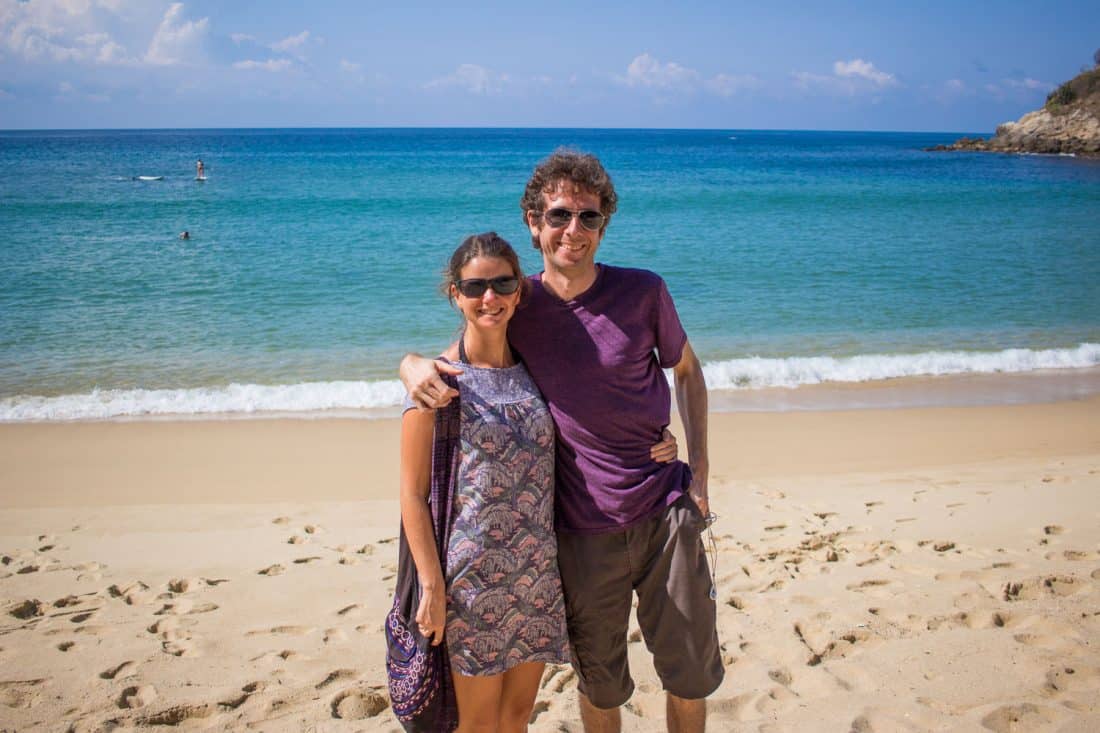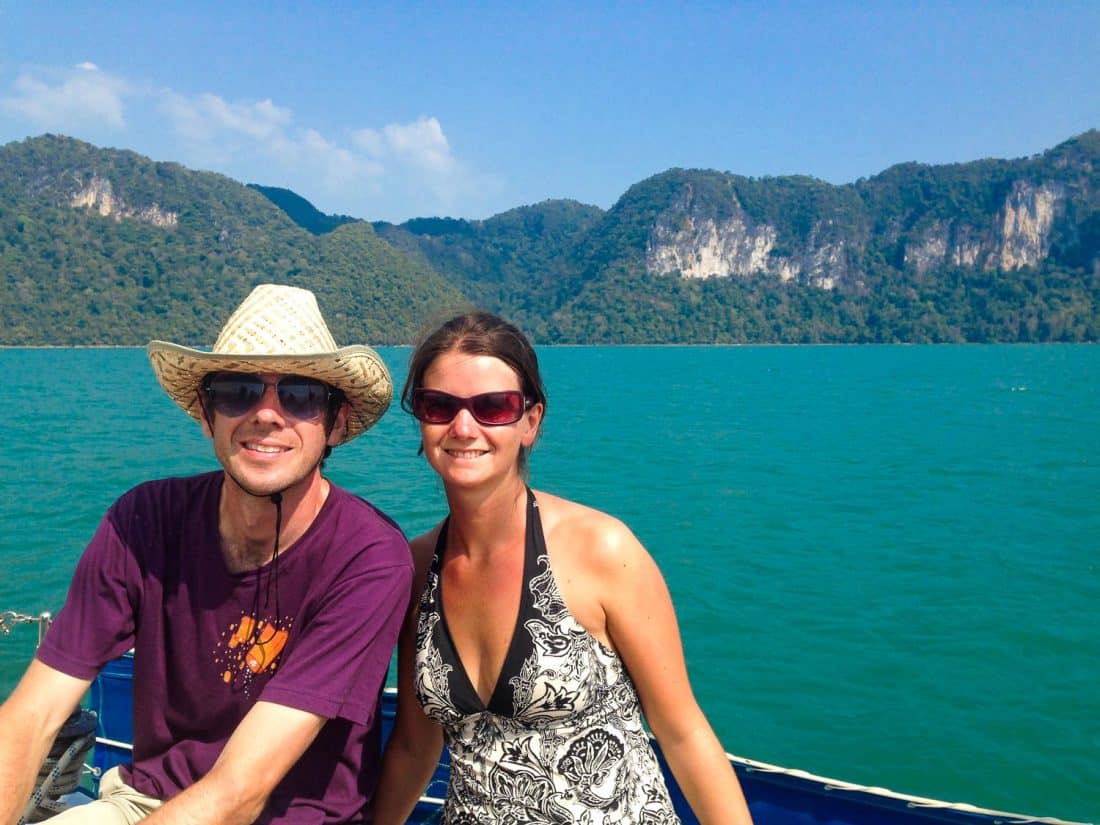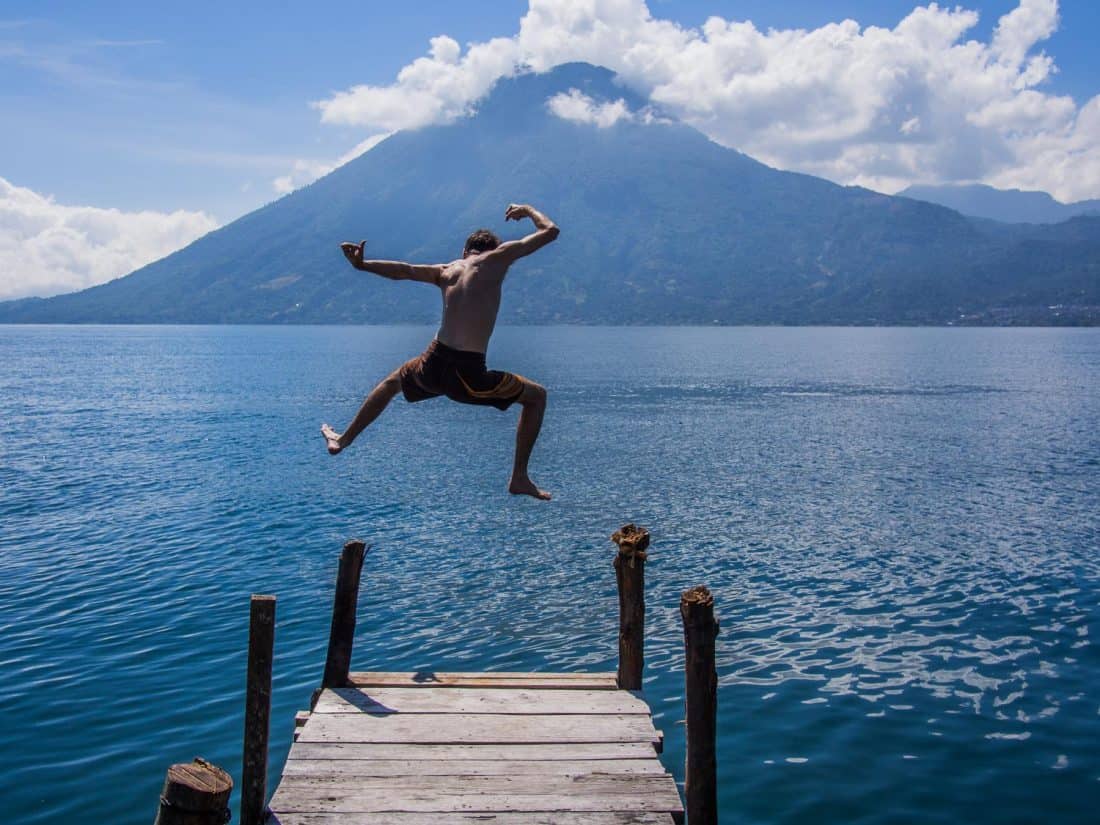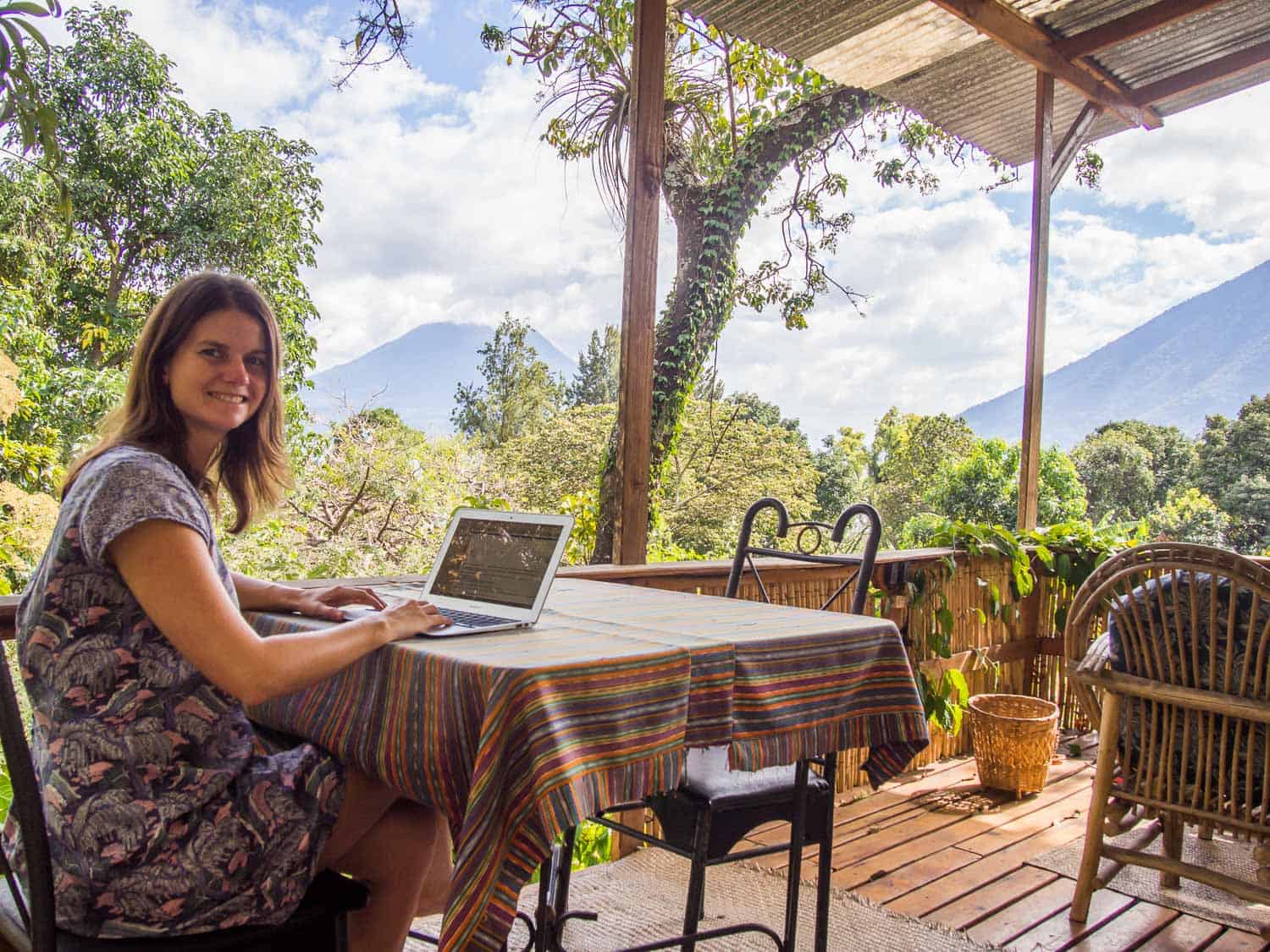This page contains affiliate links. Please read our disclosure for more info.
This post is a little late as we’re nearly half way through our sixth year as digital nomads, but here’s what we spent in our fifth year of living and working on the road.
Our annual expenses are broken down into four areas:
- Daily Expenses – Day to day living costs including visas, accommodation, food, in country transport, toiletries, clothes, and low cost activities.
- Flights – Domestic and international flights.
- Extras – Insurance, major medical expenses, expensive activities, and other large unusual costs.
- Business – These expenses aren’t related to travel but to running our online business. They include technology (laptops, hard drives, iPhone, camera), website hosting, domains, software, and cloud storage.
These are our expenses for year 5 of our travels from March 2014-February 2015. This is for two people in British pounds. The second row has the amounts converted into US dollars at the current exchange rate in July 2015.
| Daily Expenses | Flights | Extras | Business | Total | |
|---|---|---|---|---|---|
| GBP | £13,812 | £3,948 | £1,127 | £3,313 | £22,200 |
| USD | $21,550 | $6,160 | $1,758 | $5,169 | $34,637 |
This works out at £1,850 ($2,886) a month for us both with an average of £1,150 ($1,794) a month spent on general living expenses with the extras spent at various points during the year.
We spent almost £2000 less than in year 4 (which was itself £1000 less than year 3), but have stayed in the range of £21,000 to £25,000 for the last four years, averaging around £23,000 ($35,880) a year or £1900 ($2964) a month.
We haven’t tried to stick to a particular budget. Although we track all of our expenses with an app and set target budgets for each destination, we aren’t very strict about it. We prefer comfortable accommodation, often splurge on fancy meals, and do whatever activities we’re interested in.
To give you a better idea of what we spent our money on here’s a breakdown of each area of spending.
Daily Expenses
In year 5 we travelled to 10 countries in Southeast Asia, Europe, and North and Central America. Fairly typically we spent five months in more expensive destinations (Europe and the US) and the rest of the year in cheaper countries.
We started the year travelling around Cambodia and Malaysia, staying in most places for about a week. We splurged on a five day sailing course on a live aboard yacht in Langkawi, but have included that expense in Extras below. Next we spent six weeks on our favourite Thai island Koh Lanta where our expenses were quite low as it was low season and friends let us stay in their gorgeous villas for free. We stayed with Simon’s brother in Singapore for a week before heading to Europe.
We spent the summer travelling slowly around Turkey, housesitting on a remote farm in Spain, and visiting friends and family in England. In the US we attended a festival in Portland, stayed with friends in San Francisco and San Diego, and I ran my first half marathon in Sonoma.
It was a busy summer and autumn so from November we settled down for nearly three months in the tiny village of San Marcos on stunning Lake Atitlan, Guatemala. When our visa expired we crossed the border to Mexico, travelled to a couple of places before renting a house with friends in beach town Puerto Escondido for a month.

Although we spent a lot of time in expensive destinations we balanced out the costs by housesitting and staying with friends, and by ending the year in Guatemala. We always spend less when we slow down and rent a place for a few months. Although our daily expenses were a little lower this year, when we did pay for accommodation we chose comfortable guesthouses (in Asia) or nice Airbnb apartments (in Europe and the US).
You can read our highlights from year 5 here.
Flights
We flew a lot this year as we’ve become less tolerant of overnight buses which aren’t much fun and leave us tired for days afterwards. We flew between countries in Southeast Asia (mostly with Air Asia) and Europe, and cities in the US. Our major flights were between Singapore and Istanbul, London to Los Angeles (quite reasonable on Norwegian Air), and San Diego to Guatemala City. We also booked a cheap Norwegian flight from New York to London so that we’d have proof of onward travel for entering the US, and then changed the date later—even with the flight change fee it was cheaper than other airlines. We don’t usually bother with proof of onward travel but the US is one country we don’t like to mess with.
Extras
This includes the sailing course we did in Malaysia, Simon’s CBT (the first stage in getting a motorbike licence), a new backpack, and travel insurance (we use True Traveller who are one of the few digital nomad friendly insurance companies).

Business
Our regular expenses to run our business include hosting, domains, cloud storage, newsletter (Mailchimp), VPN (Witopia), and software (Adobe Creative Cloud). We also experimented a little with Facebook advertising. Our National Insurance payments in the UK (where we are registered self employed) are also included here.
New gear included an iPhone 6 and a hard drive. Business costs were lower than the previous year as we didn’t buy a new laptop or camera.
Destination Budgets for Year 5
We’ve written more detailed budget breakdowns for the following places:
- Cambodia
- Malaysia
- Turkey
- San Marcos La Laguna at Lake Atitlan, Guatemala (where we lived for three months)
- Puerto Escondido, Mexico (where we lived for a month)
How We Track Our Expenses
App
Even if you aren’t on a strict budget we believe that tracking your expenses is important so that you are aware of your spending. We enter each item we spend into our iPhone app. We created Trail Wallet over two years ago to help us and other travellers easily track expenses while travelling (Update: after 10 years, we have taken the sad decision to remove Trail Wallet from the App Store so it is no longer available).
Other Methods
I also use a spreadsheet to track our income and overall expenses (in the way we’ve shared above). On the first of each month I check every bank balance, plus our Paypal accounts and the amount of cash we have on hand, and enter the totals in another spreadsheet so I have a clear picture of exactly how much money we have. It’s a good idea to check internet banking regularly for any discrepancies.
We have multiple credit and debit cards in case we lose any, plus some emergency dollars. We manage everything by internet banking. You can read a more detailed post about how to manage your money while travelling.
Our Income
Our income comes from advertising and affiliate commissions on this site, the iPhone apps Simon makes at Voyage Travel Apps, the freelance writing I occasionally do, and rental income from a house we still own in the UK. For more details see our post on how we fund our travels.
For the last three years we broke even and year 5 was about the same, although there was a little more in our bank account by the end of the year. Our goal is to be able to start adding to our savings and this is starting to happen in year 6. We could earn more but we’re not motivated by money and prefer to work on things that interest us. It finally feels like that’s beginning to work out for us.

This isn’t a post to show how cheaply you can live on the road as sticking to a low budget isn’t a priority for us. It is an example of a realistic digital nomad budget for a couple staying in comfortable apartments and hotels, eating good food, and mixing slow and fast travel. In year 5 we learnt to sail a yacht, stayed in a beachfront villa in Thailand, learnt to cook Turkish food, hot air ballooned over Cappadocia, rode horses in the Alpujarras, ran a half marathon through Californian vineyards, rented an apartment with lake and volcano views in Guatemala, and released baby turtles in Mexico—all while working on what we love and spending every day together. For the quality of life we live our expenses feel like a bargain.

I reckon you had amazing savings during the Koh Lanta low season Erin. Staying at a friend’s villa rocks. We usually house sit but rented a freaking big Thai style house in Old Town literally on the bay for 1/3rd of the normal price. Low season of course. Rocking post here.
Ryan
I love seeing these posts. Sure, it’s great to see how cheaply some people can travel, but for many of us, that’s not realistic. Andy and I don’t travel on a shoestring budget, but we also don’t travel in pure luxury mode. Your budget/spending is something I can relate to because we also try to keep expenses down while splurging on fun things here and there and making sure we’re comfortable. And OMG no overnight buses!
I also want to say again how much I love Trail Wallet. We don’t travel full time, but I use the app all the time to track our expenses whether we’re traveling or at home. It’s really helpful to see what we’re spending each month, and it’s so easy to use.
Thanks Ali for your support with Trail Wallet. It’s good to know you are finding it useful at home too.
I love the way you keep track of your annual expenses. I am only able to track them when I travel – actually I downloaded Trail Wallet recently and it’s been of great help.
Cheers!
Wow, I can’t believe I didn’t find this blog earlier. It looks like I’ve got some catching up to do! So much great info on all your pages. I’m look forward to your new adventures, keep doing what you’re doing..
Cheers guys
This is a fantastic post that highlights questions that so many people (myself included) have about life as a digital nomad. I’m so glad that you have found a way to make the nomadic lifestyle work! You are an inspiration to those of us fledgling bloggers who have dreams of someday being in the same position.
You guys are SUCH an inspiration to us! As we get ready to embark on an extended drive down the PanAm highway to South America we want to become digital nomads, like you, not getting rich but funding ourselves enough to remain on the road indefinitely if we choose to. I do wish we could get your travel insurance, since we’re finding World Nomads prices have tripled since we did our last RTW trip in 2007-2008, but, alas, being US citizens that won’t work. Regardless, great post and keep on traveling and inspiring!
Thanks Rhonda and good luck on your big adventure!
Tracking your expenses while on the road is a must, good thing there’s an app that works for you. Kudos for being organized though you have a very busy life on your travels.
Enjoyed reading your post, hope to see more travels in your year 6.
That was a really well put together post. I’m happy that everything is working out for you guys, and it must be good to look back at the end of a financial year, and know exactly how much was spent, where and why.
Great post i like the idea that you stay in great places and is not to much money so if you can do it i can
I have been reading your posts for nearly a year and I enjoy your website thoroughly. Your costs were particularly interesting for me (and I’m sure most people). It is wonderful that you are living the life you love.
When I was in my 20’s I used to be on the backpacker trail but now in my mid-40s with wife/kids/mortgage that is not my current reality. But one day I will be back in the saddle again.
When you are younger I think it is often a contest to see how cheaply you can live. And it was almost a contest to see how much ground you can cover in the shortest time possible, scratching “must do’s” off the list to the point of exhaustion. Clearly this is not sustainable, particularly if you are going to be on the road full time as you are. Thanks for your wonderful website. I look forward to your next installment!
I always find your cost analyses interesting because we live the same lifestyle as you do.
We slow travelled the last year in Prague, Thailand (Bangkok, Hua Hin, Nong Khai), then Croatia for 2 months. And our costs pretty much in line with yours for the year despite no house sitting.
But it’s always interesting to analyze costs on a place to place basis. Nong Khai was the cheapest place for us. But surprisingly only beat out Prague by a little bit. We were surprised by how cheap Prague can be. On the other hand, living comfortably in Bangkok was expensive and was the most expensive place over the last year. More so than Croatia.
We’re now in Budapest. And despite what people say about Budapest being cheap, it’s not. Rental about on par with Prague, but food costs much more. Again, always interesting seeing what real expenses are when actually there living daily life.
Frank (bbqboy)
That’s really interesting that Bangkok was more expensive than Prague and Croatia!
Hi, have loved reading your posts over the past few years. Thankyou.
Just come back from staying at a wonderful and tranquil place called The Sanctuary on Koh Phagnan, maybe you’ve heard of it…delicious vege food, daily yoga, meditation (and fast internet!)…the sort of place people easily stay for months. Can be done cheaply if you stay in the accommodation surrounding. Definitely worth a visit next time in Thailand!
ps, I’ve changed to android recently, any chance of seeing your budget app on there soon?
I have heard of The Sanctuary and would love to visit.
I’m afraid we have no Android plans at the moment.
This post shows that the dream is possible. Thanks for this x
The post was really informative. Thanks for sharing and looking forward to read a lot in future.
Erin & Simon – I have been reading since 2012 and LOVE it! I especially enjoy your annual budget breakdown posts. Its so inspiring to see how much travel quality and value you can create within your budget. My wife and I hope to do a similar thing in the future.
One question for you … if you didn’t have great friends willing to host you in expensive places like San Diego and San Francisco, would you still travel to those cities? And if so, how much more might that add to the annual travel cost? I’m curious as I’m trying to determine how much to save in order to travel like you, without all of the perks like great friends, sponsored tourism trips (Finland), etc. Any thoughts are appreciated and thank you for sharing your story!
We would still travel to those cities and we often do pay for accommodation in expensive places such as Portland last year and we just spent a month staying in Airbnbs in various places in Italy (including Rome). We were actually going to rent an apartment in San Francisco for a month which would probably have cost around $2000 but luckily our friend had a spare bedroom.
It’s difficult to work out exactly how much more we’d spend without staying with friends or doing a sponsored trip occasionally. If we were paying for accommodation in SF we probably would have eaten less expensive meals out for example. We also find we balance out expensive months by going to cheaper places or housesitting. The advantage of not having fixed expenses is being able to spend less when needed. I think our budget is definitely realistic for any couple even without our perks, but obviously everyone’s travel style and destinations vary.
It’s awesome how you guys stay organized and disciplined with tracking your expenses. I find that it is the easiest way to keep yourself motivated in a long run and we are actually doing the same for many years now. Enjoy the rest of the year wherever you go ;-)
We started tracking our expenses when we were saving for travel and it’s become a habit now.
Great post. My wife and I are just coming up on two years of nomadic living through Central America and are looking forward to heading to Australia later in the year. I am looking forward to trying Trip Wallet and implementing some of your cost recording techniques. Thank you. Good luck in the coming year.
Thanks Peter and I hope you find Trail Wallet useful. Happy travels!
>> We could earn more but we’re not motivated by money and prefer to work on things that interest us. <<
That's why you win at living life! Not many people get that … I hope year 6 will be as fascinating, rewarding, thrilling and beautiful as the other years! :) Cheers!
Thank you for your kind words Diana! It isn’t always an easy route to take but we feel like we’re on the right track.